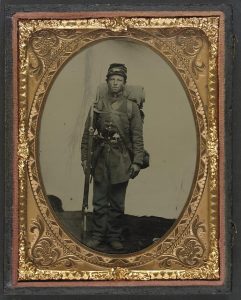Soldier or Pilgrim? “With A Bundle On His Shoulders”

Driving through the Maryland countryside last Sunday afternoon with some visiting friends from California, we had Union songs blasting from my phone. One of the “conscript songs” rotated up on the playlist. The lyrics begin with a lament that the narrator’s “true love is a soldier” and that he was drafted even though “he didn’t want to go.” The fellow had tried to get an exemption and even feigned lameness and contemplated bribery.
So now, the unlucky young man was in the army:
He’s gone to be a soldier,
With a knapsack on his back,
A fightin’ for the Union
And a livin’ on “hard tack”
Oh how he look’d like Christian,
In the Pilgrim’s Progress shown,
With a bundle on his shoulders
But with nothin’ of his own.
The last half of Verse 3 caught the attention of the church-going folks in the traveling car. And it prompted an interesting discussion for a few miles. The reference and comparison is connected many not be as familiar to modern audiences, but Civil War folks were certainly familiar with John Bunyan and his character named “Christian.”
John Bunyan lived in 17th Century England and was a Puritan minister. At that time, the Church of England persecuted the Puritan religious sect for wanting to “purify” the doctrine and theology of the official church, making it less liturgical and more in accordance to reformed beliefs and biblical doctrine authority. Consequently, Bunyan was thrown into prison for his preaching. While imprisoned, he wrote his most famous piece of literary spiritual allegory: The Pilgrim’s Progress. First published in 1678 (several years after his release), The Pilgrim’s Progress became a best-seller and is still in print today. The book was a classic in America, especially in religious circles, and was referenced in secular literary works of the era, too. Pretty much anyone in the 1860’s who heard the version of the Civil War song would have known exactly what it meant.
So what does it mean?
The Pilgrim’s Progress allegory follows a character named Christian who flees from his homeland and begins a quest to find the Celestial City. Along the way, he encounters many characters and difficult places — mostly famously, the Slough of Despond and the Giant of Doubting Castle. When Christian begins his journey, he is weighed down with “this heavy burden; but get it off myself, I cannot; nor is there any man in our country that can take it off my shoulders; therefore am I going this way…that I may be rid of my burden.” The burden allegorically represents the wrongs that Christian has committed and must bear as guilt until he reaches the “Place of Deliverance” which is represented as a place with a cross and a sepulcher. “Just as Christian came up with the cross, his burden loosed from off his shoulders, and fell from off his back, and began to tumble, and so continued to do, till it came to the mouth of the sepulcher, where it fell in, and I saw it no more…the sight of the cross…[eased] him of his burden.”
The character Christian with his burden appeared in illustrated versions of Bunyan’s story and in other works of art.



Unfortunately for the Civil War conscript in the song, while the singers may have been able to picture a man burdened down thanks to the written allegory and the art it had inspired over the centuries, the soldier’s knapsack burden was not an allegory. A typical Civil War soldier carried 50 pounds of gear, including whatever he had in his knapsack, his cartridge box, and his gun. The way to lighten his load would be to “donate” any non-essentials to the roadside. A final deliverance might come with the sign of a cross in the form of a grave marker, but not as blissfully as Christian in the story.
Thanks to the long popularity of Bunyan’s religious allegory, the description and comparison of the Civil War conscript to the Christian in the story would have made perfect sense to the 19th Century audience. Sometimes, unfamiliar phrases or even slang from the 1860’s can be easy to gloss over, but taking the time to trace the origins of the simile or metaphor can help us gain a richer appreciation of the culture, context, and meaning.

I had caught this reference the first time I heard the song. I watched a film adaptation of The Pilgrim’s Progress a lot when I was younger. Thanks for pointing this out and expounding on the connections.